Contributed by Barbara Corneo
This year the conference of the International Society for Stem Cell Research (ISSCR) was held in Boston, MA, USA.
The weather wasn’t what one would expect in June but even with the rain and cold temperatures more than 4000 stem cell researchers from all over the world met for the 11th time to talk about using all types of stem cells (embryonic, adult, iPSC and the pluripotent cells newly derived by somatic cell nuclear transfer) not only for disease modeling and drug screening but also for cell transplantation in patients with diseases affecting their heart, pancreas, brain, muscles, eyes and other organs. Nancy Witty, ISSCR Executive Director, the ISSCR staff and the ISSCR board outdid themselves this year, the program was exciting and the talks were great. A few years ago, at the 2006 ISSCR meeting, Dr. Shinya Yamanaka presented his data on the reprogramming of mouse fibroblasts into what he called “induced pluripotent stem cells” (iPSCs), generating a lot of discussion, surprise and even some skepticism. His work was based on the idea of cellular plasticity that others before him, including Dr. John Gurdon, had studied since the fifties, using other methods and other model organisms. Just a few years later, Yamanaka’s work was replicated in hundreds of labs, and he and Gurdon shared the 2012 Nobel Prize. iPSCs are soon going to be tested in clinical applications, as revealed by Dr. Masayo Takahashi at the 2012 ISSCR held in Yokohama, Japan.
Nowadays, basically every other day there is a paper being published on iPSC generation and biology. Yet, reprogramming is still very inefficient and even the best laboratories using the best methods can only reach just about 1% efficiency of reprogramming. If you ever tried to derive iPSCs, you know that even this low efficiency rate gives you enough colonies to pick and grow and analyze anyway :). But this year, Dr. Jacob Hanna from the Weissman Institute in Israel presented data showing that the chromatin regulator MBD3 is a barrier to reprogramming and knocking-down this gene increases the efficiency of mouse iPSC generation to 100%!
Another exciting talk about what can influence reprogramming was the data presented by Dr. Ritu Kumar, a research scientist at Cornell in NYC, who showed that even if not essential for reprogramming, the activation-induced cytidine deaminase AID is necessary at late stages in order to attain pluripotency. Her data, soon to be published in Nature, generated a nice discussion with Dr. Helen Blau from Stanford, who previously published on how AID is necessary for the initial steps of reprogramming. For my part, I was excited that AID, a gene that I know from my previous scientific life as an immunologist (when my colleagues Drs. Patrick Revy and Anne Durandy from Necker Hospital in Paris, France, published that mutations in this gene cause a rare immune deficiency, called hyper IgM syndrome) is now understood to be such an important character in reprogramming, bridging my past interests with the new.
Other important points that multiple talks touched on was the importance of developing efficient and reproducible differentiation protocols to drive pluripotent cells into the desired final cell product, and the need for these products to be characterized via comprehensive phenotypic and functional analyses. For example, Dr. Doug Melton from Harvard reported on the challenges that exist in the field of differentiation of pluripotent stem cells into beta cells, the cell type lost in the pancreas of patients affected by diabetes. Various laboratories are now able to obtain beta cells secreting insulin (a protein that regulates glucose levels in the blood) from iPSCs and hESCs, but unfortunately it is still hard to obtain beta cells that are glucose-responsive (i.e. can detect the glucose in the blood). Melton’s laboratory screened and found 4 chemical compounds that seem able to convert beta cells into functional glucose-responsive cells. Even with this exciting result, other challenges still exist, for example how to protect the beta cells originated in vitro from the patient’s own reactive immune system once transplanted. Dr. Melton invited other labs interested in bioengineering to help find a solution to this problem. He proposed, for example, to create encapsulated b cells that are protected from the immune system.
Thinking about the potential of stem cells for cell transplantation in all those diseases in which cells are lost, for obvious reasons, it is important to first set up trials using animal models, and usually mice and rats are used for this purpose.
Dr. Chuck Murry from Seattle is interested in generating functional cardiomyocytes from pluripotent stem cells and showed impressive movies of homogenous monolayers of beating cells!! Even more impressive were images he showed of the large number of tissue culture flasks and of the liters of media that his lab used to obtain 2 billion (!!) cardiomyocytes to inject in macaques, after a myocardial infarct was induced. Interestingly, all animals went through a period of ventricular arrhythmias that was not observed in experiments with rodents. And we all understood that when Dr. Murry said during this period he felt like he had arrhythmias too, he was not joking!!! Amazingly, he showed that after a few weeks, this issue was resolved and the iPSC-derived cardiomyocytes helped to regenerate part of the macaque heart, and were able to integrate and beat in synchrony with the host tissue. This means we are closer to using cardiomyocytes to repair the damaged human heart. Very exciting!!
Various biotech companies and scientific organizations were also present at the 2013 ISSCR meeting as exhibitors, providing all of us with an incredible amount of pens, bags, notebooks, and various other colorful gadgets, and for the luckiest ones, the possibility of winning an iPad. Most importantly, they present their newest technologies, which help make our lives in the lab easier, so that our time is spent more efficiently, hopefully resulting in more successful experiments and more publications. Last year, at the 2012 ISSCR held in Yokohama, Japan, StemCulture Inc, the company co-founded by our Director Dr. Sally Temple, introduced to the scientific community StemBeadsFGF2, microspheres that slowly release FGF2, the factor required by hESC and iPSC for pluripotency maintenance and by neural stem cells and mesenchymal stem cells for optimal growth. While last year StemBeads were a novelty and a surprise for scientists, this year a number of us were very aware of their existence. In particular, students and post-docs love these beads. If you ever worked with hESC or iPSC, you know that to maintain them in their most pluripotent state changing their media every day is required. And by every day I mean every day, even Saturday and Sunday and on your birthday and on Christmas, on the 4th of July and on your wedding anniversary and when it’s -40F outside… StemBeadsFGF2 allows one to change the media every 3 days so you can see why you also will love them. Moreover, cells grown using media supplemented with StemBeadsFGF2 differentiated better into each of the 3 germ layers, which is really an important finding. At ISSCR 2013, StemCulture Inc organized for the 1st time a party on Friday night. There we saw that post-docs can also be good dancers and successful DJs and we discovered that Prosecco is one of the most sought-after drinks. This makes me very happy, as this sparkling wine originates from the region in Italy where I come. Lots of famous PIs were also present. I had the chance to talk for the 1st time with Dr. Lee Rubin, a Harvard investigator that works on screening for small molecules and compounds in the hope of finding better treatments for diseases such as diabetes, cancer, ALS, multiple sclerosis and other motor neuron diseases. At the ISSCR Young Investigator party, we saw Dr. Len Zon, an internationally recognized expert in cancer and hematopoiesis, dance the night away. It is always nice for young investigators to realize that behind these big names there is a person that is usually very willing to spend time and talk with you. One opportunity for networking is the Meet the Expert lunch that ISSCR organizes every year, in which young investigators have the chance to sit around a table with an expert in the field and ask questions about their work, their results, their career and any other that springs to mind.
ISSCR is such a big conference covering a field that is in continuous expansion. Stem cell core facilities have such an important role in the field, as they provide education, support to their users, reagents that are quality tested and protocols that are efficient and reproducible. Core facilities make it easier for a scientist to go back to her/his lab and do experiments using stem cells. This year one of the focus sessions at ISSCR was organized by the directors of core facilities, including Dr. Sunita D’Souza from Mount Sinai in NYC. The subject was Generating collections of human iPSC and ESC lines: Establishing best practices for sharing protocols and cell lines and so many people tried to participate that the security officers of the conference center had to step up, and stay in front of the doors to block more people from entering. 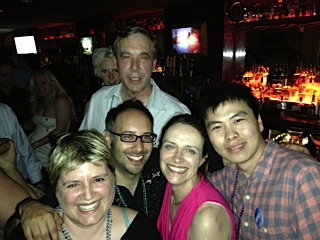 After the end of the 1st session, they were able to find more chairs and then you could see all these scientists (me included) grabbing chairs and finding spots to follow the discussion!!! I have so many friends and colleagues now that are working on stem cell research and this conference is always a great place to meet and talk about science, plan collaborations and experiments. It is not uncommon to see collaborators sitting at a table and discussing their results or new plans. Moreover, we can have a drink during poster sessions or after and gossip, complain, and share news about life in and out of the lab.
After the end of the 1st session, they were able to find more chairs and then you could see all these scientists (me included) grabbing chairs and finding spots to follow the discussion!!! I have so many friends and colleagues now that are working on stem cell research and this conference is always a great place to meet and talk about science, plan collaborations and experiments. It is not uncommon to see collaborators sitting at a table and discussing their results or new plans. Moreover, we can have a drink during poster sessions or after and gossip, complain, and share news about life in and out of the lab.
Next year the annual ISSCR meeting will be in Vancouver Canada. I am getting ready for it, because even if I didn’t win an iPad, I was lucky enough to win one of the daily raffles! I won 2 passes for the Capilano Suspension Bridge in Vancouver!!! See you all at ISSCR 2014!!!!
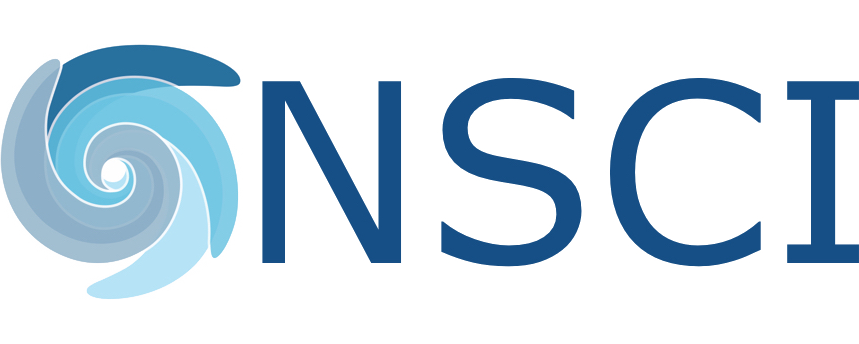
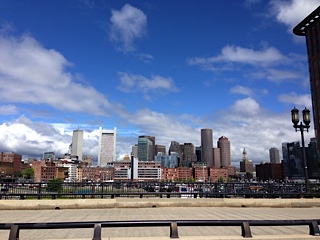
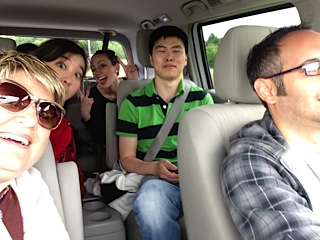
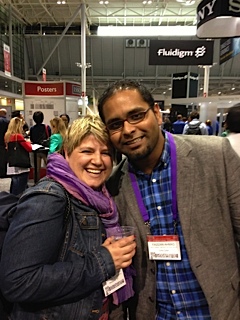
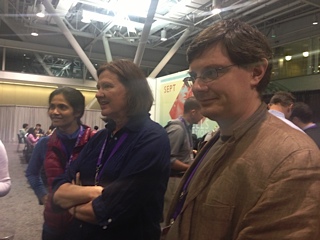
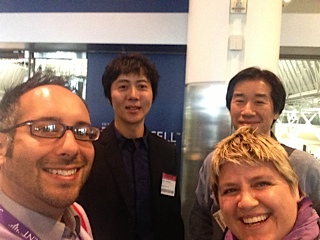
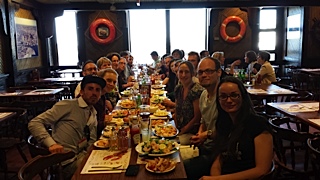
Leave a Reply